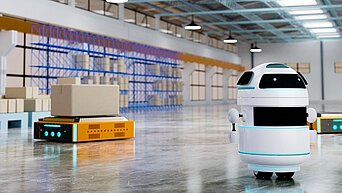
In the evolving manufacturing landscape, the push toward customized production has introduced new complexities in operational planning. Variability in job processing times, fluctuating workloads, and spatial constraints around machines challenge traditional scheduling and material handling approaches. Buffers — spaces used to temporarily store workpieces — play a critical role in mitigating these issues.
However, most existing models focus solely on local buffers, overlooking the potential of shared buffers, especially mobile ones, to enhance system performance. The paper “Integrated Material Handling and Machine Scheduling with Shared Buffers” by Amir Hosseini, Alena Otto, and Maximilian Schiffer addresses this gap by proposing a comprehensive optimization framework that integrates machine scheduling with material handling using shared buffer systems.
The Initial Situation
Manufacturing systems increasingly face the challenge of balancing customization with efficiency. Customization leads to greater variability in job processing times, which in turn causes machine starvation and blocking—conditions that reduce throughput and increase operational costs. Buffers help alleviate these issues by allowing temporary storage of jobs between machines. While local buffers are commonly used, they are limited by space and cost constraints. Shared buffers, which serve multiple machines and can be either stationary (common buffers) or mobile (e.g., mobile robots or MRs), offer a promising alternative. Despite their advantages, shared buffers are rarely considered in integrated scheduling models, and the coordination between machine scheduling and material handling remains underdeveloped.
The Findings
The authors present a mixed-integer programming (MIP) model that integrates machine scheduling with material handling, explicitly accounting for buffer capacities, transportation tasks, and the role of mobile robots. The model comprises three interconnected components:
An illustrative example demonstrates the model’s effectiveness. In a flow-shop with three machines and one MR, three scenarios are compared:
The model shows that even a single MR acting as a mobile buffer can replicate the benefits of adding a local buffer, highlighting the operational value of mobile shared buffers. Additionally, the model supports flexible decision-making regarding whether jobs should be transported directly or via a common buffer.
The Potential Implications
This integrated approach has several important implications:
Conclusion
The paper significantly contributes to production planning by introducing a robust and flexible model that integrates machine scheduling with material handling, emphasizing the strategic role of shared buffers. Through detailed modeling and illustrative examples, the authors demonstrate how mobile shared buffers—enabled by MRs—can enhance system performance, reduce blocking, and improve makespan. The proposed framework addresses a critical gap in existing research and offers practical insights for manufacturing systems aiming to balance customization with efficiency. Future work will focus on developing scalable solution methods and exploring the role of shared buffers across diverse production environments.